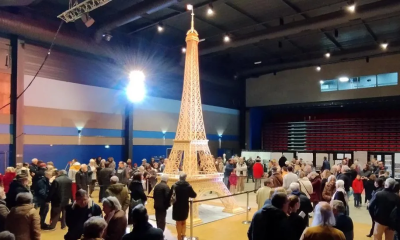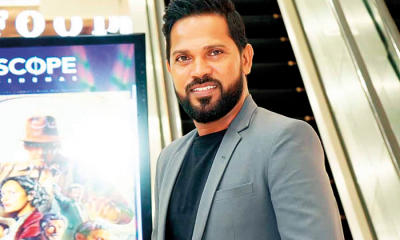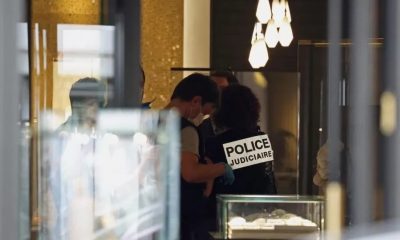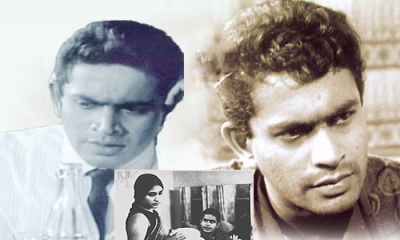Features
Paris then – bookshops, cinema, theatre, fashion and Centre Pompidor
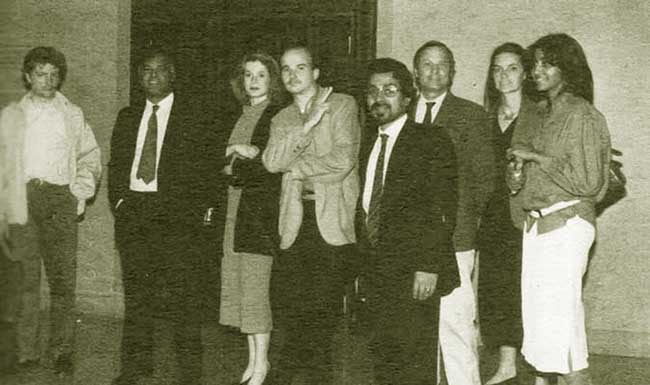
(Excerpted from volume ii of the Sarath Amunugama autobiography)
Another of Richard Ross’s (who once served the U.S. Embassy here) surprises for his visitors was the ‘Hemingway Trail’. We would table hop the cafes and bistros frequented by the famous writer in his day many years ago. Ernest Hemingway’s haunts were by now redesigned but we could locate them after reading his work ‘A Movable Feast’ which described the author’s early days in Paris as an expatriate American writer. Similarly when coming out of the Sevres—Babylone Metro I would think of Scott Fritzgerald’s evocative short story ‘I Remember Babylone’.
A walk through old Paris was like an introduction to western literature in the inter war years. Another welcome visitor was our old friend Siri Gunasinghe who by this time was teaching art in the University of Victoria in British Columbia. Siri had lived for several years in as a graduate student working on his thesis at the Sorbonne, was an outstanding scholar whose thesis which received a ‘bien’ [very good] accolade was published by the University press which is a rare honour in French academia.
He had spent a considerable amount of his time as a student at the Musee Guimet which specialized in Mahayana Buddhist exhibits which modeled on the Sanskrit treatises on art which were studied by Siri as the subject of his thesis. Unlike the British Museum which has arts and artifacts from Theravada countries the Musee Guimet which specialized on art of the ‘Extreme Orient’ – an area
carved out by the French colonial politicians – which was mainly Mahayana and had Sanskrit as the ‘lingua Franca’. Sanskrit was Siri’s academic interest and his lectures on Sanskrit literature at
Peradeniya, especially of the Sanskrit epic poem the Meghaduta, were attended also by a large number of students drawn from faculties who recognized his brilliance.
Siri was happy to spend a few days roaming around his old haunts. I took him to the Culture division of UNESCO where the specialists knew him by reputation. Specialists handling the Cultural triangle work in Sri Lanka were delighted to meet him and worked out some joint efforts in research and publications.
Bookshops
Paris is famous for its bookshops which dot the city. There are many around the Sorbonne and Boulevard Raspail where intellectuals and students gather to browse and sip a cup of hot coffee. But bookshops selling English works were not so numerous and had to be discovered through guidebooks. The most impressive was Brentano’s near the Place de Opera. It stocked the latest French and English books and promoted new books by positioning them behind their large storefront window which faced the main street.
We would spend hours browsing with no complaints from the shop staff. Unfortunately Brentanos is now closed down due to the march of technology. Another large bookshop was W.H. Smith’s on the Rue de Rivoli. It also stocked journals of every description. I also found a small bookshop near the Odeon metro which sold US publications. Its notice board carried messages and letters for expatriate American writers in Paris.
Coffee was on the house and in winter many young American writers came there because it was a well heated place. This bookshop also announced lectures by visiting writers and by attending them I met some writers who became world famous later. Tourists flocked to the small bookshop called ‘Shakespeare and Company’ by the Seine which was the meeting place of writers like Hemingway, Fritzgerald and Samuel Beckett in the thirties when they were attracted to Paris by the appreciating dollar and the depreciating franc.
Another tourist attraction were the small kiosks along the Quaffs near the river which sold secondhand books, old maps and memorabilia. If you had the time to spend it was possible to pick up valuable inscribed books which had been sold to these book shops for a pittance. I found a book with an inscription by Subhas Chandra Bose. Another recipient of several inscribed books sent by Mulk Raj Anand had sold them to a secondhand bookseller without even bothering to read the title. I was able to buy them for a song.
Students often gathered in the Latin Quarter which was full of bookshops open day and night. I spent many happy weekends in those wonderful bookshops and their small cafes which would serve snacks and hot chocolate in short order so that we could quickly get back to browsing. Another interesting feature was that we could see in those bookshops famous writers, political personalities [including Mitterand] and film stars, who invariably spent time looking for new books. They could also be seen Spending time in the nearby restaurants and bistros where tables would be reserved for them.
Cinema
Movies were shown in the posh cinema halls on the Champs Elysee’s which displayed attractive billboards advertising their films. Whenever a new film opened there would be a crowd of chic ladies and their escorts lining up on the street to buy tickets. From time to time leading film stars would come to those theatres to promote their films and face the media.
There was a similar cluster of cinema halls at the Odeon junction opposite the metro, exhibiting French films. There was a frisson in the Odeon complex where young people gathered in anticipation when a new film was released. Famous French film directors, mobbed by their fans, could be seen in the Odeon cinemas when their films were released for the first time.
In addition to these grand cinemas there were a large number of small cinema halls in the outskirts of the city which showed classics as well as pot boilers. Sometimes erotic films like `Emannuelle’ were also shown in those cinemas and attracted an audience of old men who shuffled in at the last minute. All the film classics could be seen in these ‘outstation’ cinemas and the enthusiast had to consult the newspapers or magazines to locate them.
I once went out of the city to see Lester James Pieris”God King’. The only problem was that it had been reedited and shown as the ‘Tomb of the Pharaohs’. When I mentioned this to Lester, he was not amused at the mutilation of his film but there was nothing he could do as all the rights for distribution were owned by the producer.
A group of young French film makers led by Herve Berard were introduced to me by our embassy staff. They were planning to make a film in Sri Lanka with Gamini Fonseka, after seeing him in ‘Nidhanaya’ which was shown on French TV. At about this time Geetha Kumarasinghe was in Paris and we decided to back this film together with my friend Irvin Weerackkody who was the boss of Phoenix Advertising Services.
So the whole crew moved to Sri Lanka and with Gamini and Geetha as the local stars and two young film stars from the French film industry, shot `Nobody’s Perfect’ as a murder mystery set in the Sri Lankan countryside. But we had difficulties with the French version and the film ran only for a few weeks in Colombo. This film drew stellar performances from Gamini and Geetha and deserves to be resurrected in this age of television, by our Film Corporation. It had good reviews when it was premiered in Paris.
Theatre
The Comedie Francaise was located in the heart of the city. It usually produced traditional French classics like those of Moliere. I attended several of those plays but was hindered by my inadequate knowledge of the French language. The Comedie is considered a national treasure which was a centre of resistance during the Nazi occupation. While this theatre was considered to be upmarket there were many smaller playhouses that attracted young people.
One was the ‘Vieux Colombier’ which was associated with Jean Paul Sartre and the existentialists. Their plays were staged at the Colombier which was a meeting place of French intellectuals. Equally important was the popular entertainments which are part of the Paris city scene. At the entrance to the Metros or on busy street corners would be the ‘Baskers’ or struggling musicians who would play for donations of passers by.
Some of them were really good and would be picked up by TV and nightclubs. Others were not much better than beggars, some of them winos, who would solicit a few francs. Some of the migrants – Asian and particularly, African – would also play their ethnic music and draw crowds who would invariably gather to enjoy a new experience. The tunnel approaching the Metro was warm and well lit and the Baskers’ would gather a group of admirers milling around them.
Centre Pompidou
No description of popular culture in France would be complete without a reference to the Centre Pompideau or the `Bo Bo’ as it is popularly called, in the historic Marais which was the old city market. Later the central market was relocated out of Paris. The Marais was a poor but busy quartier of Paris which historically housed a large number of Jews in its time. Since it was the main market of the city, it was open ‘twenty-four seven’.
The market attracted tough workers to load and unload meats, vegetables .and other products which serviced the ‘gastronomic capital of the world.’ Accordingly it was full of people and housed taverns, bistros, brothels, peep shows and all other attractions which are demanded by workingmen who are at a loose end between shifts.
Since the kitchens in the Marais were open late into the night the `haute bourgeoisie’ or the upper classes also dropped in late in the evening particularly after opera and theater going, for the now famous onion soup. The ingredients like raw onions, cheese, and oven baked bread were fresh off the market and the workers took it as a wholesome and nourishing meal. Onion soup soon became a staple of French cuisine which was served in the best restaurants in the city.
Outside the ‘Bo Bo’ there were jugglers, dancers, singers and puppeteers who attracted the crowds that came to see the ever changing presentations there. One presentation which remains in my memory is the premiere of Kurosawa’s film ‘Ran’ which was held in the open ground surrounding the ‘Bo Bo’. This film was produced by a French filmmaker at a time when Kurosawa was desperately in need of work.
His old sponsor Toyo Films had gone bankrupt, partly due to financing his films which were box office poison. He had even attempted suicide but had been saved at the last minute. The French rescue mission was supported by Mitterrand who was a great film goer. His nephew Philip Mitterrand was a well-known film critic in France.
The grateful Kurosawa brought his film to France for a grand premiere which was attended by President Mitterand himself. Thanks to Herve Berard I secured an invitation to that gala affair which was a ‘black tie’ event. A special technology to simultaneously project the film from three projectors was used on that occasion and we sat in front of a giant screen to view this fantastic film which was Kurosawa’s Japanese version of Shakespeare’s ‘King Lear’.
After the screening there was an ‘al fresco’ dinner and we had a chance to meet Kurosawa. He was quite different from the average Japanese in that he was quite lean and tall. He spoke English fluently and was happy at the acclaim received at the highest levels in France. Later I read that the producer complained that he had lost money on ‘Ran’. Kurosawa was a demanding director and his crowd scenes of thousands of Samurai, which was a feature of many of his films, cost a lot of money. But the director would not compromise on his high standards which helped in making him one of the all-time greats of the cinema.
Fashion
Paris has always been the fashion capital of the world. All the top fashion designers have their establishments in Paris just as the Italian designers have their ateliers in Milan. Naturally for a trade which deals with glamour and big money these fashion houses are located in the most exclusive parts of the city, particularly Avenue Montaigne and Fauborg St Honore which are close to each other and in the Concorde area.
On free days we would walk along the tip-market streets just to admire the store front displays. The street is dotted with small cafes and eateries which buyers, designers and models frequently use during their breaks from work. About Once a year the top designers unveil their latest creations before fashion critics and buyers of ‘pret a porter’ products which are marketed by leading retailers particularly those in the United States which is the home of the mass garment market. Those buyers are treated like royalty by the designers since their bulk purchases constitute the ‘bread and butter’ of the couturiers.
The fashion industry is a complex business. Not everyone knows how it really works. Thanks to Sri Lankan youngsters who are linked to the fashion industry at the basic level I could unravel the sociology of the ‘Rag Trade’. There are thousands of beautiful young women who flock to Paris from the rural areas of the country hoping to break into the fashion and film industry. For this they have to register with the modeling companies which are of varying service quality ranging from top models to call girls.
These agencies invest in their ‘properties’ by giving them training, clothing and on occasion, if they spot a winner, an allowance The chosen girls are sent to well-known photographers, who are legion in Paris, to prepare an album of photographs which is retained by the agency. This dossier is a hopeful girl’s or boy’s claim to fame among thousands of similar aspirants who want to emulate the stars.
Fashion photographers, Film Directors, Theatre Directors, journalists and even business houses seeking to employ PR hostesses contact these modeling agencies to get a list of possible employees. It is here that our expatriates come in They are employed by the agencies to take the required dossien to their client companies which are located in different parts of Paris. These ‘messenger boys’ whiz past in their Velos’ or small motor bicycles, carrying selected dossiers in brightly colored envelopes, to the potential employers.
The agency decides on the dossiers to be submitted, which can mean the difference between fame and obscurity for the model to be. They are constantly after the agency and the couriers for their dossiers to be sent for consideration by the show business bigwigs. Many of these would-be models seek the goodwill of the couriers, hoping that they would help to position their claims better. Many of our parties held in the Fauborg St Honore area had many of them pretty girls arriving on the arms of young SriLankan expatriates working as ‘messenger boys’.
Features
The heart-friendly health minister

by Dr Gotabhya Ranasinghe
Senior Consultant Cardiologist
National Hospital Sri Lanka
When we sought a meeting with Hon Dr. Ramesh Pathirana, Minister of Health, he graciously cleared his busy schedule to accommodate us. Renowned for his attentive listening and deep understanding, Minister Pathirana is dedicated to advancing the health sector. His openness and transparency exemplify the qualities of an exemplary politician and minister.
Dr. Palitha Mahipala, the current Health Secretary, demonstrates both commendable enthusiasm and unwavering support. This combination of attributes makes him a highly compatible colleague for the esteemed Minister of Health.
Our discussion centered on a project that has been in the works for the past 30 years, one that no other minister had managed to advance.
Minister Pathirana, however, recognized the project’s significance and its potential to revolutionize care for heart patients.
The project involves the construction of a state-of-the-art facility at the premises of the National Hospital Colombo. The project’s location within the premises of the National Hospital underscores its importance and relevance to the healthcare infrastructure of the nation.
This facility will include a cardiology building and a tertiary care center, equipped with the latest technology to handle and treat all types of heart-related conditions and surgeries.
Securing funding was a major milestone for this initiative. Minister Pathirana successfully obtained approval for a $40 billion loan from the Asian Development Bank. With the funding in place, the foundation stone is scheduled to be laid in September this year, and construction will begin in January 2025.
This project guarantees a consistent and uninterrupted supply of stents and related medications for heart patients. As a result, patients will have timely access to essential medical supplies during their treatment and recovery. By securing these critical resources, the project aims to enhance patient outcomes, minimize treatment delays, and maintain the highest standards of cardiac care.
Upon its fruition, this monumental building will serve as a beacon of hope and healing, symbolizing the unwavering dedication to improving patient outcomes and fostering a healthier society.We anticipate a future marked by significant progress and positive outcomes in Sri Lanka’s cardiovascular treatment landscape within the foreseeable timeframe.
Features
A LOVING TRIBUTE TO JESUIT FR. ALOYSIUS PIERIS ON HIS 90th BIRTHDAY

by Fr. Emmanuel Fernando, OMI
Jesuit Fr. Aloysius Pieris (affectionately called Fr. Aloy) celebrated his 90th birthday on April 9, 2024 and I, as the editor of our Oblate Journal, THE MISSIONARY OBLATE had gone to press by that time. Immediately I decided to publish an article, appreciating the untiring selfless services he continues to offer for inter-Faith dialogue, the renewal of the Catholic Church, his concern for the poor and the suffering Sri Lankan masses and to me, the present writer.
It was in 1988, when I was appointed Director of the Oblate Scholastics at Ampitiya by the then Oblate Provincial Fr. Anselm Silva, that I came to know Fr. Aloy more closely. Knowing well his expertise in matters spiritual, theological, Indological and pastoral, and with the collaborative spirit of my companion-formators, our Oblate Scholastics were sent to Tulana, the Research and Encounter Centre, Kelaniya, of which he is the Founder-Director, for ‘exposure-programmes’ on matters spiritual, biblical, theological and pastoral. Some of these dimensions according to my view and that of my companion-formators, were not available at the National Seminary, Ampitiya.
Ever since that time, our Oblate formators/ accompaniers at the Oblate Scholasticate, Ampitiya , have continued to send our Oblate Scholastics to Tulana Centre for deepening their insights and convictions regarding matters needed to serve the people in today’s context. Fr. Aloy also had tried very enthusiastically with the Oblate team headed by Frs. Oswald Firth and Clement Waidyasekara to begin a Theologate, directed by the Religious Congregations in Sri Lanka, for the contextual formation/ accompaniment of their members. It should very well be a desired goal of the Leaders / Provincials of the Religious Congregations.
Besides being a formator/accompanier at the Oblate Scholasticate, I was entrusted also with the task of editing and publishing our Oblate journal, ‘The Missionary Oblate’. To maintain the quality of the journal I continue to depend on Fr. Aloy for his thought-provoking and stimulating articles on Biblical Spirituality, Biblical Theology and Ecclesiology. I am very grateful to him for his generous assistance. Of late, his writings on renewal of the Church, initiated by Pope St. John XX111 and continued by Pope Francis through the Synodal path, published in our Oblate journal, enable our readers to focus their attention also on the needed renewal in the Catholic Church in Sri Lanka. Fr. Aloy appreciated very much the Synodal path adopted by the Jesuit Pope Francis for the renewal of the Church, rooted very much on prayerful discernment. In my Religious and presbyteral life, Fr.Aloy continues to be my spiritual animator / guide and ongoing formator / acccompanier.
Fr. Aloysius Pieris, BA Hons (Lond), LPh (SHC, India), STL (PFT, Naples), PhD (SLU/VC), ThD (Tilburg), D.Ltt (KU), has been one of the eminent Asian theologians well recognized internationally and one who has lectured and held visiting chairs in many universities both in the West and in the East. Many members of Religious Congregations from Asian countries have benefited from his lectures and guidance in the East Asian Pastoral Institute (EAPI) in Manila, Philippines. He had been a Theologian consulted by the Federation of Asian Bishops’ Conferences for many years. During his professorship at the Gregorian University in Rome, he was called to be a member of a special group of advisers on other religions consulted by Pope Paul VI.
Fr. Aloy is the author of more than 30 books and well over 500 Research Papers. Some of his books and articles have been translated and published in several countries. Among those books, one can find the following: 1) The Genesis of an Asian Theology of Liberation (An Autobiographical Excursus on the Art of Theologising in Asia, 2) An Asian Theology of Liberation, 3) Providential Timeliness of Vatican 11 (a long-overdue halt to a scandalous millennium, 4) Give Vatican 11 a chance, 5) Leadership in the Church, 6) Relishing our faith in working for justice (Themes for study and discussion), 7) A Message meant mainly, not exclusively for Jesuits (Background information necessary for helping Francis renew the Church), 8) Lent in Lanka (Reflections and Resolutions, 9) Love meets wisdom (A Christian Experience of Buddhism, 10) Fire and Water 11) God’s Reign for God’s poor, 12) Our Unhiddden Agenda (How we Jesuits work, pray and form our men). He is also the Editor of two journals, Vagdevi, Journal of Religious Reflection and Dialogue, New Series.
Fr. Aloy has a BA in Pali and Sanskrit from the University of London and a Ph.D in Buddhist Philosophy from the University of Sri Lankan, Vidyodaya Campus. On Nov. 23, 2019, he was awarded the prestigious honorary Doctorate of Literature (D.Litt) by the Chancellor of the University of Kelaniya, the Most Venerable Welamitiyawe Dharmakirthi Sri Kusala Dhamma Thera.
Fr. Aloy continues to be a promoter of Gospel values and virtues. Justice as a constitutive dimension of love and social concern for the downtrodden masses are very much noted in his life and work. He had very much appreciated the commitment of the late Fr. Joseph (Joe) Fernando, the National Director of the Social and Economic Centre (SEDEC) for the poor.
In Sri Lanka, a few religious Congregations – the Good Shepherd Sisters, the Christian Brothers, the Marist Brothers and the Oblates – have invited him to animate their members especially during their Provincial Congresses, Chapters and International Conferences. The mainline Christian Churches also have sought his advice and followed his seminars. I, for one, regret very much, that the Sri Lankan authorities of the Catholic Church –today’s Hierarchy—- have not sought Fr.
Aloy’s expertise for the renewal of the Catholic Church in Sri Lanka and thus have not benefited from the immense store of wisdom and insight that he can offer to our local Church while the Sri Lankan bishops who governed the Catholic church in the immediate aftermath of the Second Vatican Council (Edmund Fernando OMI, Anthony de Saram, Leo Nanayakkara OSB, Frank Marcus Fernando, Paul Perera,) visited him and consulted him on many matters. Among the Tamil Bishops, Bishop Rayappu Joseph was keeping close contact with him and Bishop J. Deogupillai hosted him and his team visiting him after the horrible Black July massacre of Tamils.
Features
A fairy tale, success or debacle

Sri Lanka-Singapore Free Trade Agreement
By Gomi Senadhira
senadhiragomi@gmail.com
“You might tell fairy tales, but the progress of a country cannot be achieved through such narratives. A country cannot be developed by making false promises. The country moved backward because of the electoral promises made by political parties throughout time. We have witnessed that the ultimate result of this is the country becoming bankrupt. Unfortunately, many segments of the population have not come to realize this yet.” – President Ranil Wickremesinghe, 2024 Budget speech
Any Sri Lankan would agree with the above words of President Wickremesinghe on the false promises our politicians and officials make and the fairy tales they narrate which bankrupted this country. So, to understand this, let’s look at one such fairy tale with lots of false promises; Ranil Wickremesinghe’s greatest achievement in the area of international trade and investment promotion during the Yahapalana period, Sri Lanka-Singapore Free Trade Agreement (SLSFTA).
It is appropriate and timely to do it now as Finance Minister Wickremesinghe has just presented to parliament a bill on the National Policy on Economic Transformation which includes the establishment of an Office for International Trade and the Sri Lanka Institute of Economics and International Trade.
Was SLSFTA a “Cleverly negotiated Free Trade Agreement” as stated by the (former) Minister of Development Strategies and International Trade Malik Samarawickrama during the Parliamentary Debate on the SLSFTA in July 2018, or a colossal blunder covered up with lies, false promises, and fairy tales? After SLSFTA was signed there were a number of fairy tales published on this agreement by the Ministry of Development Strategies and International, Institute of Policy Studies, and others.
However, for this article, I would like to limit my comments to the speech by Minister Samarawickrama during the Parliamentary Debate, and the two most important areas in the agreement which were covered up with lies, fairy tales, and false promises, namely: revenue loss for Sri Lanka and Investment from Singapore. On the other important area, “Waste products dumping” I do not want to comment here as I have written extensively on the issue.
1. The revenue loss
During the Parliamentary Debate in July 2018, Minister Samarawickrama stated “…. let me reiterate that this FTA with Singapore has been very cleverly negotiated by us…. The liberalisation programme under this FTA has been carefully designed to have the least impact on domestic industry and revenue collection. We have included all revenue sensitive items in the negative list of items which will not be subject to removal of tariff. Therefore, 97.8% revenue from Customs duty is protected. Our tariff liberalisation will take place over a period of 12-15 years! In fact, the revenue earned through tariffs on goods imported from Singapore last year was Rs. 35 billion.
The revenue loss for over the next 15 years due to the FTA is only Rs. 733 million– which when annualised, on average, is just Rs. 51 million. That is just 0.14% per year! So anyone who claims the Singapore FTA causes revenue loss to the Government cannot do basic arithmetic! Mr. Speaker, in conclusion, I call on my fellow members of this House – don’t mislead the public with baseless criticism that is not grounded in facts. Don’t look at petty politics and use these issues for your own political survival.”
I was surprised to read the minister’s speech because an article published in January 2018 in “The Straits Times“, based on information released by the Singaporean Negotiators stated, “…. With the FTA, tariff savings for Singapore exports are estimated to hit $10 million annually“.
As the annual tariff savings (that is the revenue loss for Sri Lanka) calculated by the Singaporean Negotiators, Singaporean $ 10 million (Sri Lankan rupees 1,200 million in 2018) was way above the rupees’ 733 million revenue loss for 15 years estimated by the Sri Lankan negotiators, it was clear to any observer that one of the parties to the agreement had not done the basic arithmetic!
Six years later, according to a report published by “The Morning” newspaper, speaking at the Committee on Public Finance (COPF) on 7th May 2024, Mr Samarawickrama’s chief trade negotiator K.J. Weerasinghehad had admitted “…. that forecasted revenue loss for the Government of Sri Lanka through the Singapore FTA is Rs. 450 million in 2023 and Rs. 1.3 billion in 2024.”
If these numbers are correct, as tariff liberalisation under the SLSFTA has just started, we will pass Rs 2 billion very soon. Then, the question is how Sri Lanka’s trade negotiators made such a colossal blunder. Didn’t they do their basic arithmetic? If they didn’t know how to do basic arithmetic they should have at least done their basic readings. For example, the headline of the article published in The Straits Times in January 2018 was “Singapore, Sri Lanka sign FTA, annual savings of $10m expected”.
Anyway, as Sri Lanka’s chief negotiator reiterated at the COPF meeting that “…. since 99% of the tariffs in Singapore have zero rates of duty, Sri Lanka has agreed on 80% tariff liberalisation over a period of 15 years while expecting Singapore investments to address the imbalance in trade,” let’s turn towards investment.
Investment from Singapore
In July 2018, speaking during the Parliamentary Debate on the FTA this is what Minister Malik Samarawickrama stated on investment from Singapore, “Already, thanks to this FTA, in just the past two-and-a-half months since the agreement came into effect we have received a proposal from Singapore for investment amounting to $ 14.8 billion in an oil refinery for export of petroleum products. In addition, we have proposals for a steel manufacturing plant for exports ($ 1 billion investment), flour milling plant ($ 50 million), sugar refinery ($ 200 million). This adds up to more than $ 16.05 billion in the pipeline on these projects alone.
And all of these projects will create thousands of more jobs for our people. In principle approval has already been granted by the BOI and the investors are awaiting the release of land the environmental approvals to commence the project.
I request the Opposition and those with vested interests to change their narrow-minded thinking and join us to develop our country. We must always look at what is best for the whole community, not just the few who may oppose. We owe it to our people to courageously take decisions that will change their lives for the better.”
According to the media report I quoted earlier, speaking at the Committee on Public Finance (COPF) Chief Negotiator Weerasinghe has admitted that Sri Lanka was not happy with overall Singapore investments that have come in the past few years in return for the trade liberalisation under the Singapore-Sri Lanka Free Trade Agreement. He has added that between 2021 and 2023 the total investment from Singapore had been around $162 million!
What happened to those projects worth $16 billion negotiated, thanks to the SLSFTA, in just the two-and-a-half months after the agreement came into effect and approved by the BOI? I do not know about the steel manufacturing plant for exports ($ 1 billion investment), flour milling plant ($ 50 million) and sugar refinery ($ 200 million).
However, story of the multibillion-dollar investment in the Petroleum Refinery unfolded in a manner that would qualify it as the best fairy tale with false promises presented by our politicians and the officials, prior to 2019 elections.
Though many Sri Lankans got to know, through the media which repeatedly highlighted a plethora of issues surrounding the project and the questionable credentials of the Singaporean investor, the construction work on the Mirrijiwela Oil Refinery along with the cement factory began on the24th of March 2019 with a bang and Minister Ranil Wickremesinghe and his ministers along with the foreign and local dignitaries laid the foundation stones.
That was few months before the 2019 Presidential elections. Inaugurating the construction work Prime Minister Ranil Wickremesinghe said the projects will create thousands of job opportunities in the area and surrounding districts.
The oil refinery, which was to be built over 200 acres of land, with the capacity to refine 200,000 barrels of crude oil per day, was to generate US$7 billion of exports and create 1,500 direct and 3,000 indirect jobs. The construction of the refinery was to be completed in 44 months. Four years later, in August 2023 the Cabinet of Ministers approved the proposal presented by President Ranil Wickremesinghe to cancel the agreement with the investors of the refinery as the project has not been implemented! Can they explain to the country how much money was wasted to produce that fairy tale?
It is obvious that the President, ministers, and officials had made huge blunders and had deliberately misled the public and the parliament on the revenue loss and potential investment from SLSFTA with fairy tales and false promises.
As the president himself said, a country cannot be developed by making false promises or with fairy tales and these false promises and fairy tales had bankrupted the country. “Unfortunately, many segments of the population have not come to realize this yet”.
(The writer, a specialist and an activist on trade and development issues . )


